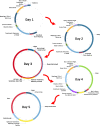In-Season Nutrition Strategies and Recovery Modalities to Enhance Recovery for Basketball Players: A Narrative Review
- PMID: 34905181
- PMCID: PMC9023401
- DOI: 10.1007/s40279-021-01606-7
In-Season Nutrition Strategies and Recovery Modalities to Enhance Recovery for Basketball Players: A Narrative Review
Abstract
Basketball players face multiple challenges to in-season recovery. The purpose of this article is to review the literature on recovery modalities and nutritional strategies for basketball players and practical applications that can be incorporated throughout the season at various levels of competition. Sleep, protein, carbohydrate, and fluids should be the foundational components emphasized throughout the season for home and away games to promote recovery. Travel, whether by air or bus, poses nutritional and sleep challenges, therefore teams should be strategic about packing snacks and fluid options while on the road. Practitioners should also plan for meals at hotels and during air travel for their players. Basketball players should aim for a minimum of 8 h of sleep per night and be encouraged to get extra sleep during congested schedules since back-to back games, high workloads, and travel may negatively influence night-time sleep. Regular sleep monitoring, education, and feedback may aid in optimizing sleep in basketball players. In addition, incorporating consistent training times may be beneficial to reduce bed and wake time variability. Hydrotherapy, compression garments, and massage may also provide an effective recovery modality to incorporate post-competition. Future research, however, is warranted to understand the influence these modalities have on enhancing recovery in basketball players. Overall, a strategic well-rounded approach, encompassing both nutrition and recovery modality strategies, should be carefully considered and implemented with teams to support basketball players' recovery for training and competition throughout the season.
© 2021. The Author(s).
Conflict of interest statement
Jon Davis, Sara Oikawa, Kevin Luhrs, Bridget Sopena, and Lindsay Baker are employees of the Gatorade Sports Science Institute, a division of PepsiCo, Inc. The views expressed in this article are those of the authors and do not necessarily reflect the position or policy of PepsiCo, Inc. Shona Halson, Jessica Stephens, and Shane O’Riordan declare that they have no conflicts of interest relevant to the content of this review.
Figures
References
Publication types
MeSH terms
LinkOut - more resources
Full Text Sources


